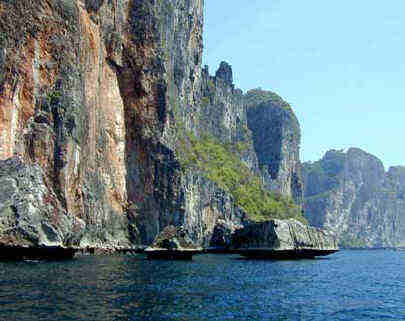Coastal Karst
By Dean Smart
When seawater and freshwater come together a special thing happens concerning caves and Karst. A process called ‘mixing corrosion’ happens which is the result of mixing the two different kinds of water.
 This process of Karst is very easy to see in coastal areas. Look at a limestone cliff where it enters the sea. There will usually be a prominent overhang, or ‘notch’, at sea level. This notch is created where fresh rainwater running down the cliff meets the seawater. The mixture of the two waters is very acidic and dissolves much limestone. Oysters and other mollusks help by making holes in the limestone and weakening it. Tide and wave action in SE Asia is small and their influence is minor. Most important is the mixing corrosion effect of fresh and salt waters and the action of mollusks.
This process of Karst is very easy to see in coastal areas. Look at a limestone cliff where it enters the sea. There will usually be a prominent overhang, or ‘notch’, at sea level. This notch is created where fresh rainwater running down the cliff meets the seawater. The mixture of the two waters is very acidic and dissolves much limestone. Oysters and other mollusks help by making holes in the limestone and weakening it. Tide and wave action in SE Asia is small and their influence is minor. Most important is the mixing corrosion effect of fresh and salt waters and the action of mollusks.
In the case of cenotes (or ‘hongs’ in local Thai language), the same processes are active. Caves and large rooms form inside limestone islands where fresh and salt water mix. The roofs of these rooms eventually collapse due to sea level changes or a weak roof and they open up to the surface. Then trees and surface animals can invade.
More mixing corrosion, mollusks and wave action help to remove the boulders left over when the roof collapses. The result is that most limestone cliffs next to the sea have no boulders or ‘scree’ at their base.
Changes
 Twelve thousand years ago, the sea level in SE Asia was 100m lower than it is today because water was taken up by the Arctic and Antarctic to make ice. Thailand and Malaysia were joined to Borneo and Sumatra by land. Caves were forming during this time in limestone mountains that are today submerged beneath the sea. These caves can be seen in various locations around Ao Phangnga in Southern Thailand. They are completely submerged beneath the sea but contain speleothems that show that once they had air in them and were above sea level. Similarly, there are dry caves in towers on the land about 50m above present day sea level. These caves contain the shells of marine mollusks and prove that the sea was at least 50m higher sometime in the past.
Twelve thousand years ago, the sea level in SE Asia was 100m lower than it is today because water was taken up by the Arctic and Antarctic to make ice. Thailand and Malaysia were joined to Borneo and Sumatra by land. Caves were forming during this time in limestone mountains that are today submerged beneath the sea. These caves can be seen in various locations around Ao Phangnga in Southern Thailand. They are completely submerged beneath the sea but contain speleothems that show that once they had air in them and were above sea level. Similarly, there are dry caves in towers on the land about 50m above present day sea level. These caves contain the shells of marine mollusks and prove that the sea was at least 50m higher sometime in the past.
> KARST by definition: an irregular limestone region with sinks, underground streams, and caves.

